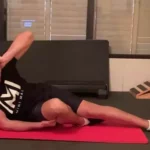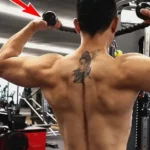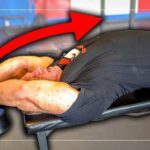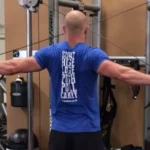Are your hamstrings lagging behind in strength and definition? The Nordic curl is a powerhouse move that targets these crucial muscles, bolstering both form and function. This article will unveil the steps to master this dynamic exercise, ensuring you unlock its full potential for stronger hamstrings.
Dive in to transform your lower body workout!
What is a Nordic Hamstring Curl?

Nordic Hamstring Curls are a powerful lower body exercise that specifically target the hamstrings. By focusing on eccentric hamstring training, this exercise helps improve athletic performance and strengthen the posterior chain.
Hamstring anatomy and function
Your hamstrings are a group of muscles along the back of your thigh. They let you bend your knee and move your hip backward. Because they cross two joints, these muscles play a big part in many things you do, like running, jumping, and climbing.
Strong hamstrings can boost how well you perform in sports or daily life.
The Nordic hamstring curl exercise makes these important muscles strong by using eccentric muscle actions. This is when your muscle lengthens as it gets stronger. Think of it like slowly letting down a heavy box rather than dropping it.
Training this way helps build muscle power which can lead to better athletic skills and fewer injuries.
Benefits of Nordic Hamstring Curls
Nordic Hamstring Curls make your leg muscles, especially the hamstrings, very strong. They focus on the part of a muscle action that is the strongest: eccentric actions. This means when you do Nordic curls, your hamstrings become more powerful in a way other exercises might not match.
Stronger hamstrings help improve your sports skills like sprinting and keep you safe from injuries.
These curls are also great for making big hamstring muscles and helping with glute strength, which lifts and tightens your buttocks. If you want better athletic performance or just stronger legs for everyday life, adding this exercise to your routine can be a big win.
Now let’s get set up so you can start doing Nordic Hamstring Curls right away!
Setting Up for Nordic Hamstring Curls
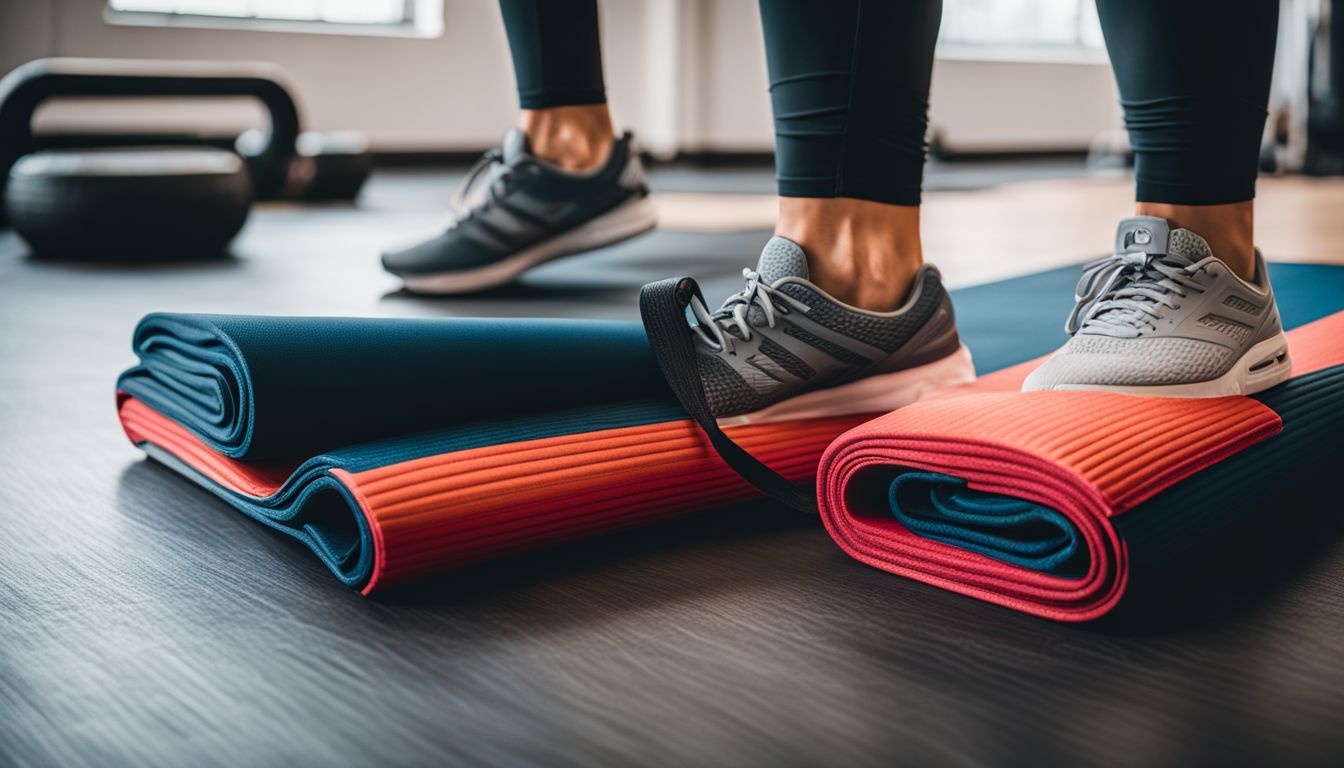
Getting ready for Nordic hamstring curls is key to doing them right. You need to set up in a way that’s safe and lets you use good form.
- Find a stable surface: Your knees should be on something soft like a gym mat. This protects your knees.
- Secure your feet: Your ankles must be held down firmly. You can use heavy gym equipment, ask a partner to hold them, or hook them under something sturdy.
- Position your body straight: Keep your body in line from your head to your knees. Pretend you’re a plank of wood.
- Set the distance right: Don’t be too close or too far from what’s holding your feet. Find a spot where you feel balanced.
- Take it slow: Ease into the move gently, especially if you’re new to this exercise.
Performing Nordic Hamstring Curls
To perform Nordic hamstring curls, start by securing your feet under a sturdy object or with the help of a partner. Lower your body slowly to the ground, using your hamstrings to control the descent, and then push yourself back up using your arms.
Focus on maintaining proper form and controlling the movement throughout to maximize the effectiveness of this exercise.
Proper form and technique
To perform Nordic hamstring curls with proper form, begin by kneeling on a soft surface with both feet secured. Keep your hips fully extended, and lower your body slowly toward the ground while maintaining tight core muscles.
Your hands may be used to support you as you descend until you reach your full range of motion. Engage your hamstrings and glutes to return to the starting position. Throughout the movement, it’s important to maintain a straight line from head to knees without arching or rounding the back.
Maintaining proper technique is crucial for avoiding injury and maximizing the benefits of Nordic hamstring curls. As you gradually progress in this exercise, ensure that there is control throughout the entire range of motion and no compensatory movements such as hip dropping or using momentum to assist in returning upward.
Progression techniques
To progress in Nordic hamstring curls, consider these techniques:
- Increase Range of Motion: Gradually lower the body closer to the ground during the eccentric phase.
- Add Resistance: Introduce resistance bands or weights to intensify the exercise.
- Eccentric Overload: Extend the lowering phase duration to further challenge the hamstrings.
- Single-Leg Variation: Perform Nordic curls using one leg at a time to increase difficulty and target each leg independently.
- Partner Assistance: Incorporate a partner to provide resistance during both the concentric and eccentric phases for added challenge.
- Tempo Control: Focus on controlling the speed of each phase, emphasizing both the lowering and lifting motions.
Alternative exercises
After mastering the Nordic hamstring curl, it is beneficial to incorporate alternative exercises to further strengthen and challenge the hamstrings. Here are some effective alternative exercises:
- Romanian Deadlifts: This exercise emphasizes the eccentric phase of the movement, similar to Nordic curls, focusing on hamstring activation while also engaging the glutes and lower back.
- Glute-Ham Raises: Performing this exercise using body weight or with added resistance targets the hamstrings and glutes, promoting strength and stability throughout the lower body.
- Single-Leg Romanian Deadlifts: By isolating each leg, this exercise improves balance and stability while effectively targeting the hamstrings for greater strength and muscle activation.
- Kettlebell Swings: This dynamic movement engages the posterior chain, including the hamstrings and glutes, promoting power development and functional strength.
- Slide Board Leg Curls: Utilizing a slide board challenges the hamstrings through a full range of motion, enhancing muscle control and coordination while providing a unique stimulus for growth and strength development.
Programming Nordic Hamstring Curls
Determine the frequency, sets, and reps that work best for your training goals and learn how to break through plateaus with effective programming. Ready to take your hamstring strength to the next level? Read on for more!
Frequency
Consistency is essential when it comes to the frequency of performing Nordic hamstring curls. To see progress and prevent injuries, aim to include this exercise in your workout routine 2-3 times per week.
This consistent training schedule helps challenge and strengthen the hamstrings over time, leading to significant improvements in strength and athletic performance.
By incorporating regular sessions of Nordic hamstring curls into your weekly training plan, you can effectively target the hamstrings for increased strength without overloading them with excessive sessions.
Sets and reps
To maximize your Nordic hamstring curl benefits, the right sets and reps are crucial. Aim for 3-4 sets of 6-10 repetitions per set for optimal muscle strengthening. This range promotes muscle growth while allowing sufficient recovery between sets.
As you progress, gradually increase the number of reps or sets to keep challenging your hamstrings. Maintaining a consistent routine with appropriate sets and reps will help you achieve stronger hamstrings and improve your athletic performance over time.
As part of a lower body workout plan, including the Nordic hamstring curl with the recommended sets and reps can lead to significant improvements in hamstring strength, which is vital for overall leg muscle strengthening and athletic performance enhancement.
Breaking through plateaus
Now that you have a good understanding of the sets and reps for Nordic hamstring curls, let’s talk about breaking through plateaus. Plateaus can occur when your progress in strength or muscle development stagnates.
To overcome plateaus, consider increasing the difficulty of your Nordic hamstring curls by incorporating tempo variations, adding resistance with bands or weights, or adjusting the range of motion.
Additionally, trying different exercises like Romanian deadlifts or single-leg stiff-leg deadlifts can shock your muscles into new growth. It’s important to continually challenge your hamstrings with varied techniques to keep progressing.
Safety and Injury Prevention
In the safety and injury prevention section, we’ll cover common mistakes to avoid during Nordic Hamstring Curls and emphasize the importance of warming up and stretching before engaging in any hamstring exercises.
This section will help you minimize the risk of injury while maximizing the effectiveness of your workout.
Common mistakes to avoid
When performing Nordic hamstring curls, it’s important to be mindful of common mistakes that can hinder your progress and lead to potential injury. Here are some key errors to avoid:
- Allowing the hips to drop during the movement, which reduces the engagement of the hamstrings and places strain on the lower back.
- Failing to maintain a straight body position throughout the exercise, leading to improper muscle activation and less effective strengthening.
- Relying too much on momentum or assistance from partners when executing the movement, compromising the intended eccentric muscle action.
- Using inadequate progression techniques, such as not gradually increasing difficulty or resistance, hindering continuous improvement in hamstring strength.
Importance of warming up and stretching
Warming up and stretching are crucial for preparing the body before engaging in Nordic hamstring curls. Warming up increases blood flow to the muscles, helping to prevent injury during the workout.
Stretching improves flexibility, which is essential for performing exercises with proper form and preventing muscle strains. Research has shown that incorporating warm-up activities can enhance athletic performance by improving muscle function and movement efficiency.
Additionally, including a specific warm-up routine tailored to the muscles involved in Nordic hamstring curls can help activate those muscles and prepare them for the exercise. Furthermore, stretching post-workout aids in reducing muscle soreness and promoting faster recovery.
Choosing the Right Equipment
When it comes to Nordic hamstring curls, choosing the right equipment is crucial for a safe and effective workout. Nordic straps, a Nordic bench, or other options can greatly impact your ability to perform the exercise with proper form and prevent injury.
Nordic straps
Nordic straps are essential for performing Nordic hamstring curls, providing the necessary support to anchor your feet and ensure stability during the movement. These straps allow you to adjust the length and tension, catering to your specific strength and exercise needs.
When used correctly, Nordic straps assist in maintaining proper form and control throughout the entire range of motion, helping you maximize the effectiveness of each repetition. Additionally, Nordic straps offer a versatile option for individuals who may not have access to a dedicated Nordic curl bench, making it easier to incorporate this beneficial exercise into your workout routine.
Moving forward, let’s delve into exploring the key considerations surrounding \”- Nordic bench\”.
Nordic bench
When setting up for Nordic hamstring curls, the Nordic bench can be a valuable piece of equipment. It provides stability and support to ensure proper form during the exercise, reducing the risk of injury.
The Nordic bench also allows for an adjustable range of motion, making it suitable for individuals at various fitness levels and accommodating progression in the exercise.
Incorporating a Nordic bench into your training routine can enhance the effectiveness of hamstring strengthening exercises like Nordic curls. Its design promotes safe and controlled movements while targeting the hamstrings, contributing to improved lower body strength and athletic performance over time.
Other options
In addition to the Nordic straps and benches, there are alternative options for performing hamstring-strengthening exercises. Resistance bands can be used to simulate the movement of Nordic hamstring curls, providing a portable and affordable option for individuals looking to improve their hamstring strength.
Additionally, using a stability ball or exercise ball can offer an alternative way to target the hamstrings and engage the core muscles while performing similar movements. These options provide versatility in training environments and can be beneficial for individuals seeking variations in their lower body workouts.
When it comes to diversifying training routines, incorporating other exercises like Romanian deadlifts, glute-ham raises, or single-leg hip thrusts can complement Nordic curl training.
By integrating these exercises into a comprehensive lower body workout regimen, individuals can effectively target not only the hamstrings but also other key muscle groups involved in athletic performance and leg strength development.
Conclusion
In conclusion, mastering Nordic hamstring curls can significantly strengthen your hamstrings and enhance athletic performance. By understanding the proper form and techniques, individuals can maximize the benefits of this exercise.
Incorporating progressive variations will continually challenge the hamstrings for improved strength and flexibility. With consistent practice and attention to detail, Nordic curls can become a valuable addition to any lower body workout routine.
Take the time to master this exercise for lasting improvements in leg strength and overall athletic performance.




